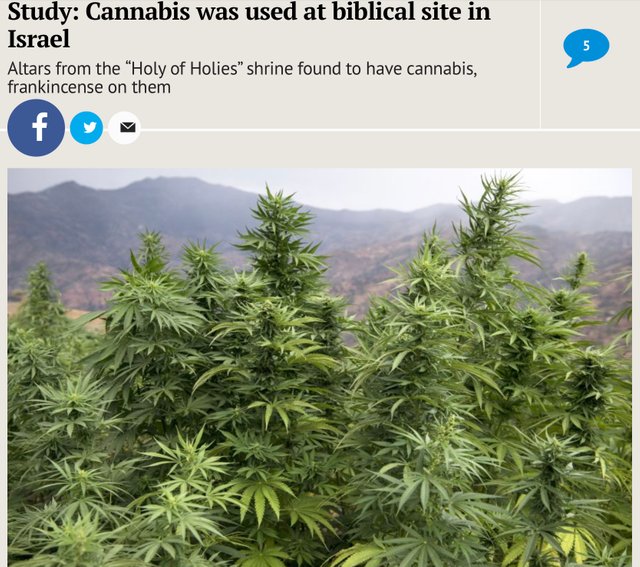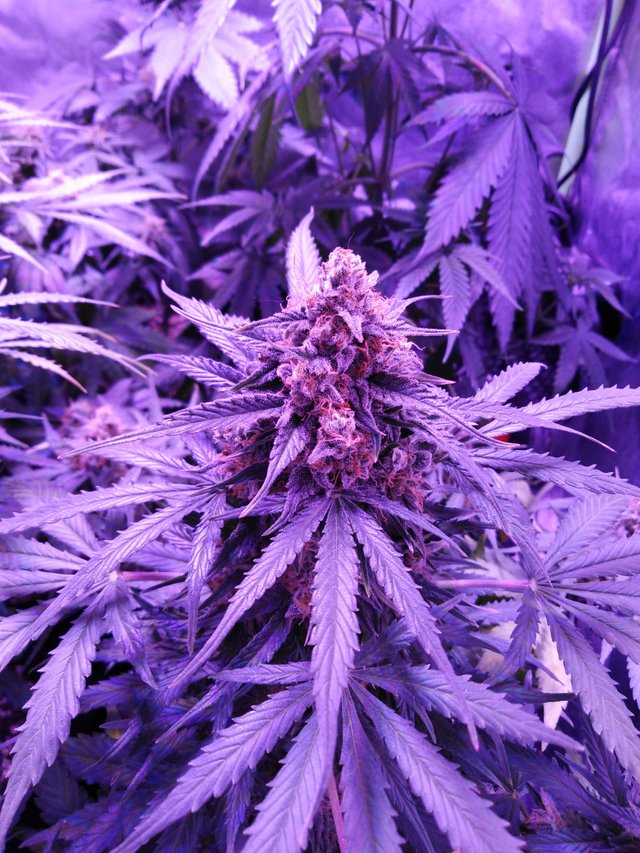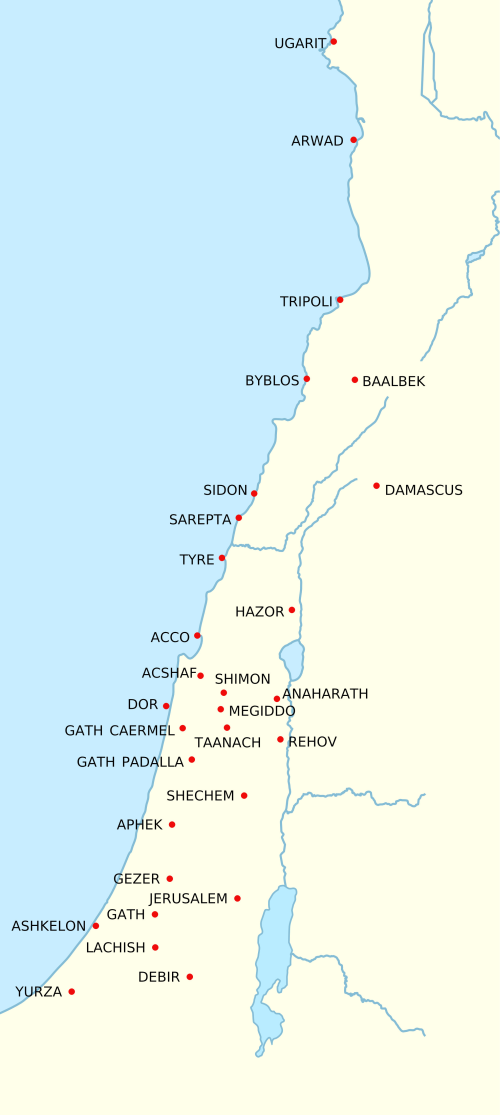Study: Cannabis was used at biblical site in Israel (Canna-an) Altars from the “Holy of Holies” shrine found to have cannabis, frankincense on them
Breaking News .... that many of us have been blogging about for years.
If you can read Hebrew and Aramaic you see that the word “kaneh bosm” Cannabis comes from the Bible ... Exodus 30:23 in the making of the Holy Oil of Annointment and Incense ...
The holy anointing oil described in Exodus 30:22-25 was created from:
Pure myrrh (מר דרור mar deror) 500 shekels (about 6 kg)
Sweet cinnamon (קינמון בשם kinnemon besem) 250 shekels (about 3 kg)
Kaneh bosem (קְנֵה-בֹשֶׂם kaneh bosm) 250 shekels (about 3 kg)
Cassia (קדה kiddah) 500 shekels (about 6 kg)
Olive oil (שמן זית shemen zayit) one hin (about 6 liters, or 5.35 kg)
Kaneh bosem (קְנֵה-בֹשֶׂם kaneh bosm) https://en.wikipedia.org/wiki/Holy_anointing_oil
Cannabis is the key ingredient in the revelation and mystery of God in the Hebrew Bible. It is the key to understanding the healing miracles of Jesus (Yeshu ha Notzri) Who used Kanehbosm / Cannabis Smoke, and Cannabis Oil to heal the sick and raise the dead.
Some day Science will catch up to these so called “Miracles” and the correct recipe and ratios of THC to CBD and other Cannabinoids and herbal mixtures will be recreated.
News: https://www.mercurynews.com/2020/05/28/study-cannabis-was-used-at-biblical-site-in-israel/
By Kristen Rogers | CNN
If there were any more fun facts to learn about cannabis, its ritualistic use at a biblical site in Israel can now be added to the list.
In 1963, two limestone altars were found at the entrance to the “Holy of Holies” of a Judahite shrine at Beersheba Valley, in Israel’s Tel Arad, an archaeological mound located west of the Dead Sea and surrounded by mountain ridges known as the Arad Plain.
The site is divided into a lower city and an upper hill. Inside the site, there is a shrine devoted to Yahweh, the Hebrew name of God used in the Bible.
Analysis of the materials on two altars, now housed in the Israel Museum, Jerusalem, found they contained cannabis ( Kaneh Bosm) and frankincense, according to a study published Thursday May 28 2020 in the journal Tel Aviv.
This is the first time that physical evidence of cannabis has been identified in the Ancient Near East, according to the study authors.
“We know from all around the Ancient Near East and around the world that many cultures used hallucinogenic materials and ingredients in order to get into some kind of religious ecstasy,” said lead author Eran Arie, curator of Iron Age and Persian Periods archaeology in the Israel Museum, Jerusalem.
“We never thought about Judah taking part in these cultic practices. The fact that we found cannabis in an official cult place of Judah says something new about the cult of Judah,” Arie said. The study’s finding regarding frankincense also provided further insight into the ingredients used in Jerusalem incense, he added.
Several other cultures, such as the Gaddi tribe of the Himalayas, the Buganda kingdom of Africa and the Tenetehara of Brazil, have used cannabis recreationally and for ecstasy in cultic ceremonies, according to previous studies.
Some tribes also used cannabis for medicinal purposes, the study said. A 1993 study on the materials on the remains of a teenage girl who died during labor in an ancient cave in Jerusalem found cannabis was likely used to reduce childbirth pain.
“What stands out most to me is that cannabis was used in concert with frankincense, rather than being mixed with frankincense or other identifiable plant products,” said Robert C. Clarke, an independent ethnobotanical researcher who was not part of the study. “This implies that there were special independent connotations assigned to the use of each plant substance.”

The Land of Canna .... The theory has been advanced that the name comes from the Hebrew root-verb kana which denotes order from chaos, a blending, or synchronous existence. The word Kana means to collect, gather together, roll up and fold ... as in making of a joint. It also means to make low, subdued and mellow.
The Canna-nite is one who rolls up joints of Kaneh-Bosm, smokes up and gets stoned, subdued and made low ( high)
The region prospered through trade because of its location. It was the terminus, at Gaza, for the Incense Routes which wound up from the Kingdom of Saba in Arabia to then divide into diverse courses upwards throughout Mesopotamia and down through Egypt. It was also a nexus of trade between Mesopotamia, Egypt, and Libya. The Canaanite-Phoenicians were expert shipwrights and seamen and participated in trade directly, sharing their cultural values with other nationalities and importing other’s values back to their own land.
The Canaanite-Phoenicians developed the first alphabetic writing system, further developed mathematical principles from Mesopotamia, were renowned in the ancient world for their skill in shipbuilding and navigating the seas, and have also been cited as the early source or inspiration for the mythology of the Greek gods. The alphabet, however, is considered their greatest achievement.
Source: https://www.ancient.eu/canaan/
Canna-an derives from the term from Hurrian Kinahhu, referring to the colour purple, so that Canna-an and Phoenicia would be synonyms ("Land of Purple"). Tablets found in the Hurrian city of Nuzi in the early 20th century appear to use the term Kinahnu as a synonym for red or purple dye, laboriously produced by the Kassite rulers of Babylon from murex molluscs as early as 1600 BC, and on the Mediterranean coast by the Phoenicians from a byproduct of glassmaking. Purple cloth became a renowned Canaanite export commodity which is mentioned in Exodus. The dyes may have been named after their place of origin. The name 'Phoenicia' is connected with the Greek word for "purple", apparently referring to the same product, but it is difficult to state with certainty whether the Greek word came from the name, or vice versa. The purple cloth of Tyre in Phoenicia was well known far and wide and was associated by the Romans with nobility and royalty.
Their clothes were made from purple hemp.

Canaan (/ˈkeɪnən/; Northwest Semitic: knaʿn; Phoenician: 𐤊𐤍𐤏𐤍 – Kenāʿan; Hebrew: כְּנַעַן – Kənáʿan, in pausa כְּנָעַן – Kənā́ʿan; Biblical Greek: Χανααν – Khanaan[1]; Arabic: كَنْعَانُ – Kan‘ān) was a Semitic-speaking civilization and region in the Ancient Near East during the late 2nd millennium BC. The name Canaan appears throughout the Bible, where it corresponds to the Levant, in particular to the areas of the Southern Levant that provide the main setting of the narrative of the Bible: Phoenicia, Philistia, Israel, and other nations.
The word Canaanites serves as an ethnic catch-all term covering various indigenous populations—both settled and nomadic-pastoral groups—throughout the regions of the southern Levant or Canaan.[2] It is by far the most frequently used ethnic term in the Bible.[3] In the Book of Joshua, Canaanites are included in a list of nations to exterminate,[4] and later described as a group which the Israelites had annihilated. Biblical scholar Mark Smith notes that archaeological data suggests "that the Israelite culture largely overlapped with and derived from Canaanite culture... In short, Israelite culture was largely Canaanite in nature.":13–14[7][8] The name "Canaanites" is attested, many centuries later, as the endonym of the people later known to the Ancient Greeks from c. 500 BC as Phoenicians, and after the emigration of Canaanite-speakers to Carthage (founded in the 9th century BC), was also used as a self-designation by the Punics (chanani) of North Africa during Late Antiquity.
Canaan had significant geopolitical importance in the Late Bronze Age Amarna period (14th century BC) as the area where the spheres of interest of the Egyptian, Hittite, Mitanni and Assyrian Empires converged. Much of modern knowledge about Canaan stems from archaeological excavation in this area at sites such as Tel Hazor, Tel Megiddo, En Esur, and Gezer.
